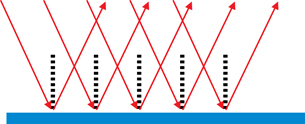Module 5
1. Module 5
1.17. Page 6
Module 5—Wave Theory of Light
 Lesson Summary
Lesson Summary
At the start of this lesson you were asked the following essential questions:
- What is regular and diffuse reflection?
- What is the law of reflection?
- How do I draw a ray diagram, and what does it represent?
- How are images formed in flat and curved mirrors, and how are ray diagrams used to predict and explain their characteristics?
Specular (regular) and diffuse reflection can be illustrated using ray diagrams, which use arrows to identify the path of the light.


All reflections are governed by the law of reflection, which states that the angle of incidence is equal to the angle of reflection measured from the normal to the surface.
Ray diagrams are based on the law of reflection, which states that the angle of reflection relative to the normal line is equal to the angle of incidence relative to the normal line. Ray diagrams are used to predict the position and characteristics of images in both plane (flat) and curved mirrors.
Images are defined by their magnification (relative to the object), attitude (up or down relative to the principal axis), and position (relative to the mirror surface). They are also classified as being real, where light rays converge, or virtual, where light rays only appear to have converged.
The mirror equation also describes image formation. It is based on the geometry of ray diagrams and relates the focal length of a curved mirror to the image and object positions according to ![]() . In addition, the magnification of an image is the ratio of the image height to the object height according to
. In addition, the magnification of an image is the ratio of the image height to the object height according to ![]() . Positive and negative sign conventions are used in conjunction with these equations to describe all the characteristics of the image.
. Positive and negative sign conventions are used in conjunction with these equations to describe all the characteristics of the image.
Many of today’s modern technologies have evolved from our understanding of reflection. Digital light processing, telescopes, and satellite dishes are all excellent applications of the law of reflection.
Lesson Glossary
incident ray: an incoming ray of light
normal line: a straight, dashed line drawn perpendicular to the mirror surface at the point of reflection
reflected ray: an outgoing ray of light
Θi (Θin): the angle between the incident ray and the normal line
Θr (Θout): the angle between the reflected ray and the normal line